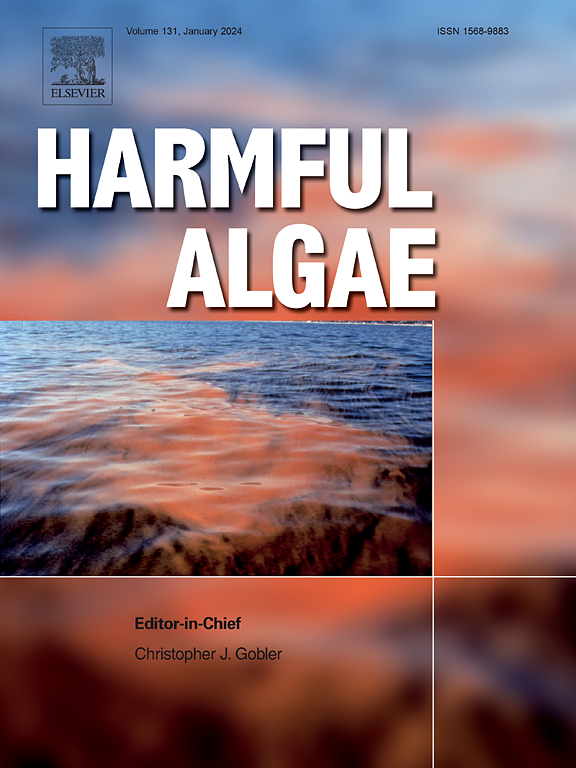监测蓝藻华与补充测量-一个类似的故事讲述了使用高通量成像,光学传感器,光学显微镜和卫星为基础的方法
IF 4.5
1区 生物学
Q1 MARINE & FRESHWATER BIOLOGY
引用次数: 0
摘要
目前存在几种监测蓝藻的方法,部分基于区分蓝藻与其他浮游植物的特征,如色素沉着和形态。然而,尚不确定是否所有的方法提供类似的见解发展和性质的蓝藻华。重要的是要了解测量的一致性水平,特别是在新方法的情况下。原位成像流式细胞术提供了高频率的群落组成信息,但很少用于丝状开花形成的蓝藻。为了了解不同方法是否一致,我们比较了使用Imaging FlowCytobot (IFCB)、CytoSense (CS)、藻蓝蛋白(PC)和叶绿素(Chl) a荧光和浊度传感器、光学显微镜和基于卫星的蓝藻积累频率(FCA)收集的多年生物量数据。2018-2022年夏季,波罗的海Utö大气和海洋研究站记录了连续的高通量数据,以及光学显微镜和邻近卫星观测的样本。IFCB蓝藻生物量模式与CS和PC荧光最接近。IFCB也描述了与FCA相似的华花,并在一定程度上描述了浊度,但与Chl a荧光不同。IFCB和光学显微镜在华花发育和种类组成上一致,但在确切生物量上存在差异。我们的研究表明,IFCB和CS都适合研究丝状蓝藻,原位成像流式细胞术通过提供详细的高频分类群特异性信息,为蓝藻监测提供了有价值的支持。尽管如此,对快速生物过程如开花发育的最佳全面覆盖是通过并行使用多种观察技术实现的。本文章由计算机程序翻译,如有差异,请以英文原文为准。
Monitoring cyanobacteria blooms with complementary measurements – a similar story told using high-throughput imaging, optical sensors, light microscopy, and satellite-based methods
Several methods to monitor cyanobacteria exist, based partly on characteristics that differentiate cyanobacteria from other phytoplankton, such as pigmentation and morphology. However, it is not certain whether all methods give similar insights into the development and properties of a cyanobacterial bloom. It is important to understand the level of consistency of measurements, especially in the case of novel methods. In situ imaging flow cytometry provides community composition information at high frequency but has been little used for filamentous bloom-forming cyanobacteria. To understand if different methods agree, we compared multi-year biomass data collected with Imaging FlowCytobot (IFCB), CytoSense (CS), phycocyanin (PC) and chlorophyll (Chl) a fluorescence, and turbidity sensors, light microscopy, and satellite-based Frequency of Cyanobacteria Accumulations (FCA). Continuous high-throughput data was recorded at Utö Atmospheric and Marine Research Station in the Baltic Sea during summers 2018–2022, along with samples for light microscopy and adjacent satellite observations. The IFCB cyanobacteria biomass pattern most closely resembled those of CS and PC fluorescence. IFCB also described the blooms similarly to FCA, and to some extent to turbidity, but differed from Chl a fluorescence. IFCB and light microscopy agreed on the bloom development and species composition but differed concerning exact biomass. Our study demonstrates that both IFCB and CS are suitable for studying filamentous cyanobacteria and that in situ imaging flow cytometry provides valuable support for cyanobacteria monitoring by yielding detailed high-frequency taxon-specific information. Still, the best overall coverage of rapid biological processes such as bloom development is achieved with the parallel use of multiple observation techniques.
求助全文
通过发布文献求助,成功后即可免费获取论文全文。
去求助
来源期刊

Harmful Algae
生物-海洋与淡水生物学
CiteScore
12.50
自引率
15.20%
发文量
122
审稿时长
7.5 months
期刊介绍:
This journal provides a forum to promote knowledge of harmful microalgae and macroalgae, including cyanobacteria, as well as monitoring, management and control of these organisms.
 求助内容:
求助内容: 应助结果提醒方式:
应助结果提醒方式:


